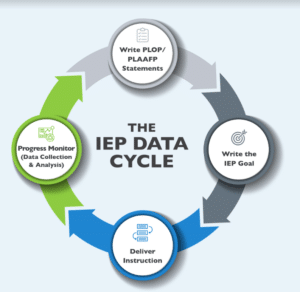Data drives a multitude, if not all, decisions in special education. When examining the cycle of instruction, the beginning and the end starts with a form of assessment and data collection. Data allows us to track student progress, identify skills that need additional support or reteaching, and fine tune what students need in their learning programs to be successful. Without data, information crucial to determining current levels of performance may be missing or incomplete, thus, leading to ineffective individualized plans. Whether a teacher or an administrator, the ongoing collection and analysis of student data provides the most current picture of a student’s skills as well as a baseline to demonstrate growth over time. Through the use of data, education teams will be able to make educational decisions that effectively meet the needs of the students.
Data can be collected through summative and/or formative assessments. Summative assessments are those methods that demonstrate a student’s knowledge at fixed points in time throughout the school year. Examples of summative assessments may include district benchmarks, state assessments, Unit tests and diagnostic assessments. Formative assessments on the other hand are forms of assessment that track student progress throughout the duration of the teaching process and drive instructional decisions. Formative assessments may include behavioral observations, teacher collected data sheets, student work samples graded by the teacher, exit tickets, etc. Data that is collected daily will provide the clearest picture of student learning, areas of challenges, and response patterns. When collecting data it is important to take into consideration when to provide the assessment, what accommodations the student requires to be successful, student background knowledge and ability to connect with the assessment questions, as well as knowing the purpose behind why the data is being collected in the first place.

A clearly written and comprehensive PLOP or PLAAFP statement is important because it is the foundation for everything in your students’ IEPs. IEP goals are based on your student present levels and that includes related services such as occupational therapy, speech and language and physical therapy, etc.
“____ is friendly and loves attention” Instead “____ greets peers appropriately for age level”
“____difficulty reading third-grade content” Instead “____ reads third-grade literature at 70 words per minute”
“____ can’t talk well” Instead “____ speaks in one or two sentences”
Specific: The goal names the specific skill or subject area and the targeted result.
Measurable: The goal is stated in such a way that the student’s progress can be measured.
Achievable: The goal represents progress that is realistic and attainable for the student.
Relevant: The goal should be personalized to the student and relevant/practical in helping the student thrive.
Time-bound: The goal includes a time frame in which your child will achieve it, with the right support and services. It also states when and how often progress will be measured.
Writing SMART IEP goals will result in enhanced guidance for teachers, enabling them to integrate explicit instruction of these goals more effectively into their classroom teaching practices. SMART IEP goals will indicate the form of data collection to be utilized for continuous monitoring of student progress. With progress monitoring, teachers will once again compile all the collected data to continue building comprehensive individualized programs for students that effectively drive student progress each year.
Contributor Bios
Lorena Hernandez, M.Ed., RBT, is a Product Enablement Specialist at TeachTown. She previously served as a Registered Behavior Technician (RBT), delivering support to students with moderate to severe disabilities across various environments such as homes, schools, and clinics. Being fluent in Spanish, Lorena nurtured a strong aspiration to aid students with disabilities in their native language, which motivated her to pursue certification in Bilingual Education (K-6th Grade) and Special Education (EC-12th Grade) in 2019. Lorena has a profound dedication to education and to attending to the individual needs of students. She obtained a Master’s Degree in Early Childhood Special Education from The University of Texas at Austin in 2020. In her free time, Lorena finds enjoyment in practicing yoga, reading, and taking long walks with her husky, Goli.
Megan Wollenburg, M.Ed., BCBA, has been passionate about working with students, especially those with learning and behavioral differences, since high school. Megan received her undergraduate degree in Low Incidence and Severe Disabilities in 2004, and her graduate degree in High Incidence Disabilities with an emphasis on Behavior Disorders and Applied Behavior Analysis in 2006 from Vanderbilt University in Nashville, TN. For eight years, Megan taught middle and high school students who received special education services across a variety of classroom settings including self-contained, resource, and general education in New York City. In 2014, Megan relocated to Texas and became an Instructional Coach for one of the largest school districts. During this time, Megan had the pleasure of working with schools across the district and teachers to assist in implementing school wide PBIS systems, Response to Intervention (RTI) practices, district-wide professional development, as well as provide ongoing support of several special education behavioral programs for students on the Autism Spectrum and individuals with emotional and behavioral challenges K- age 22. For the last 5 years, Megan has had the pleasure to be able to work as a school-based Board Certified Behavior Analyst providing support to students, families, teachers, and schools.